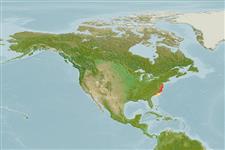Preferred temperature (Ref.
123201): 11.4 - 24.5, mean 17.2 °C (based on 60 cells).
Índice de diversidade filogenética (Ref.
82804): PD
50 = 0.5010 [Uniqueness, from 0.5 = low to 2.0 = high].
Bayesian length-weight: a=0.01318 (0.00764 - 0.02276), b=3.07 (2.92 - 3.22), in cm total length, based on LWR estimates for this species & (Sub)family-body (Ref.
93245).
Nível Trófico (Ref.
69278): 3.4 ±0.5 se; based on size and trophs of closest relatives
Generation time: 5.6 ( na - na) years. Estimated as median ln(3)/K based on 1
growth studies.
Resiliência (Ref.
120179): médio(a), tempo mínimo de duplicação da população 1,4 - 4,4 anos (tm=1; tmax=7; K=0.21(?)).
Fishing Vulnerability (Ref.
59153): Moderate vulnerability (37 of 100).
Nutrients (Ref.
124155): Calcium = 110 [48, 247] mg/100g; Iron = 0.938 [0.463, 1.756] mg/100g; Protein = 18.2 [16.8, 19.5] %; Omega3 = 0.226 [0.110, 0.434] g/100g; Selenium = 19.6 [9.7, 42.5] μg/100g; VitaminA = 16 [5, 56] μg/100g; Zinc = 0.964 [0.630, 1.421] mg/100g (wet weight);
